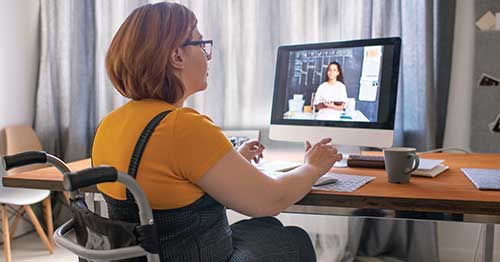Maintaining a Summer Routine for Middle Schoolers
by Cassandra Polzin
by Valerie Kirk
6 min to readIn March 2020, the world drastically changed for most students across America. With COVID-19 spreading, brick-and-mortar schools started shutting their doors to keep everyone safe at home.
Think about that pivotal moment through the eyes of a student attending a school that closed. One day they were in class surrounded by friends, classmates, and teachers laughing, learning, and connecting. The next they were in their rooms, staring at a screen, with no friends to eat lunch with, no teacher to answer questions after class, and no quick waves as they passed friends in the hallways.
Millions of students were suddenly alone.
A survey from the CDC found that more than a third of high school students reported they experienced poor mental health during the COVID-19 pandemic, and 44% reported feeling persistently sad or hopeless. One in five students said they’d thought about suicide.
While the pandemic affected every student in some way, those effects varied greatly. That same study found that school connectedness—that sense of belonging to something and feeling supported by the school community—had a significant impact on student mental health.
Students who felt connected to adults and peers at school during the pandemic were significantly less likely to have persistent feelings of sadness or hopelessness. They had fewer thoughts of suicide and a lower rate of suicide attempts.
So, why did some students feel more connected to school while learning remotely and others did not? It largely had to do with how schools handled virtual learning.
Online schools like Connections Academy® have been successfully teaching students remotely for years. With a curriculum designed for online learning, specially trained teachers, and a focus on building relationships in a virtual school environment to support social and emotional learning, students at Connections Academy and other virtual schools largely felt little impact to their learning when the world shut down due to COVID-19. They were able to still maintain their connection to the school and their peers.
Many brick-and-mortar schools had little to no experience teaching in a virtual environment. Between technology issues and a curriculum designed to be taught in person, many students experienced poor virtual classroom experiences, leading kids who were already isolated to disengage. Everything that kept them connected to their school—seeing friends, participating in class, etc.—was gone.
Students in brick-and-mortar schools that had hybrid learning, or were able to establish a virtual learning environment by taking a page from experienced full-time virtual school programs, were able to maintain some of their sense of connection to their school. They felt more connected, which helped their overall mental well-being.

Why is interaction important in the classroom? The classroom is the heartbeat of a school, regardless of if that classroom is in person or virtual. There are significant benefits of interactive learning in the classroom that go beyond academics. Students who are actively engaged in class make friends, learn how to be inclusive, and develop soft skills that will help them in their future career, including leadership, problem-solving, and teamwork. Those interactions also help students develop connections with friends, teachers, and the school itself.
For kids in brick-and-mortar schools, examples of social interaction in the classroom may seem obvious. Students in modern classrooms sit at group tables where they can talk with their peers. Teachers have students break into small groups for collaborative work. Teachers call on students and ask for feedback. Teachers may assign team projects for students to complete outside of class. Students settle into a daily routine and understand how the teacher runs the class, which is good for their mental health. Knowing what to expect—and what is expected of them—helps them organize their thoughts.
All of those examples of social interaction in the classroom also happen in virtual school! Students at Connections Academy attend live classes where teachers deliver lessons. Students are surrounded by their peers in a virtual classroom environment. They have break-out sessions, connect with each other in the chat, and engage in interactive learning with their classmates. They get to know how their teachers run the virtual class and can plan their daily schedule around live classes.
Our children are facing a mental health crisis, and our schools can help create a support system by helping students rebuild connections that were lost during the pandemic—or build new ones—to further engage students. Here are three ways to help students build connections at school:
Extracurricular clubs and activities are great ways for students to meet and connect with like-minded peers. Meeting new people and doing the things they love creates connections—and gives them a good mental health boost. Connections Academy offers hundreds of online extracurricular clubs for students to connect with others from across the country.
Exercise is not only good for the body, it is good for the mind. Students in brick-and-mortar schools can try out for school athletic teams. They could also start an athletic club, like a running club, to make more connections at school. Virtual school kids can look for local rec leagues for different opportunities to join a team. Because of the flexible virtual school schedule, virtual school kids can train throughout the day to grow their athletic abilities.
If students aren’t feeling connected to their class, their teacher can help. Reach out to them to let them know there is an issue. Teachers can find ways to engage the student in the classroom activities to help build that sense of connection.
Families in virtual school can also participate in learning pods, where students in the same school learn together in person under the supervision of a trusted adult.

Online schoolteachers can build authentic, lasting relationships with their students to help them feel more connected to the virtual school. Whereas a teacher in a brick-and-mortar school has to balance a class full of 25+ students, tending to all their needs at any given moment, online schoolteachers can spend more one-on-one time with each student. They can create a comfortable environment for students to learn while building a lasting connection with them and supporting their overall mental well-being.
Online school students demonstrated their resilience during the pandemic. If you would like to learn more about how online school works and how your student could benefit from an online learning environment where they are welcomed and feel connected, join a Connections Academy information session to learn if online school is right for you.
by Cassandra Polzin
by Connections Academy
by Cassandra Polzin
